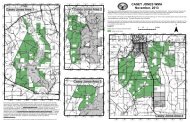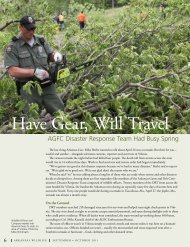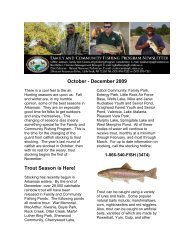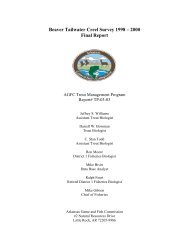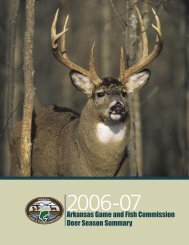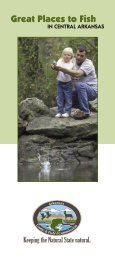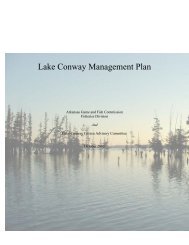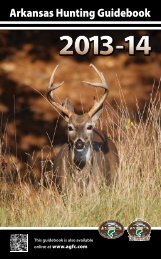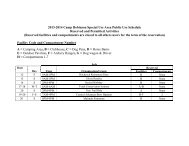All About Arkansas Crayfish - Arkansas Game and Fish Commission
All About Arkansas Crayfish - Arkansas Game and Fish Commission
All About Arkansas Crayfish - Arkansas Game and Fish Commission
Create successful ePaper yourself
Turn your PDF publications into a flip-book with our unique Google optimized e-Paper software.
Mud bugs<br />
<strong>All</strong> <strong>About</strong> <strong>Arkansas</strong> <strong>Crayfish</strong><br />
~ 1 ~
Mud bugs<br />
Brian Wagner<br />
Nongame Aquatics Biologist<br />
Andrea Daniel<br />
<strong>Fish</strong>eries Staff Biologist<br />
Marilyn Doran<br />
Fred Berry Conservation Education Center<br />
Facility Manager<br />
April Layher<br />
Aquatic Education Specialist<br />
R<strong>and</strong>y Zellers<br />
Editor<br />
Angela Sanchez<br />
Designer <strong>and</strong> Illustrator<br />
Special thanks to Chris Lukhaup for his<br />
photography contributions to this book<br />
<strong>and</strong> its companion poster.<br />
Thanks to Henry Robison, professor of<br />
biology at Southern <strong>Arkansas</strong> University,<br />
for his assistance.<br />
Summer 2007
I’m Fat Crawdaddy, the baddest bug<br />
in the bayou.<br />
I’m the toughest crayfish to swim<br />
a stream –<br />
What’s that you say? You don’t know what a crayfish is?<br />
Well let me tell you a little about my family <strong>and</strong> me.<br />
<strong>Crayfish</strong> have many names.<br />
Some people call us crawdads,<br />
crawfish <strong>and</strong> mud bugs.<br />
~ 3 ~
<strong>Crayfish</strong> are a type of<br />
crustacean (pronounced<br />
kruh-stay-shun). Crustaceans<br />
live in or near water <strong>and</strong><br />
have a tough, armor-like<br />
shell called an “exoskeleton”<br />
for protection.<br />
Crabs <strong>and</strong> lobsters also are crustaceans, but they live in<br />
the ocean. <strong>Crayfish</strong> don’t like salty water. We live in fresh<br />
water. <strong>Crayfish</strong> can be found at your favorite lake, stream<br />
or pond.<br />
~ 4 ~
Word Scramble<br />
The words below are all names of places crayfish might call home. Once<br />
you’ve unscrambled the words, use the circled letters to complete the puzzle.<br />
Can you help Fat Crawdaddy choose a place to live?<br />
VACE<br />
OUBAY<br />
WAMPS<br />
DONP<br />
ERRIV<br />
CITHD<br />
KALE<br />
_ _ _ _<br />
_ _ _ _ _<br />
_ _ _ _ _<br />
_ _ _ _<br />
_ _ _ _ _<br />
_ _ _ _ _<br />
_ _ _ _<br />
Any of these would be good h _ _ _ _ _ t<br />
for Fat Crawdaddy.<br />
~ 5 ~
<strong>Crayfish</strong> have 10 legs. If something happens to a leg, we can<br />
grow another to take its place.<br />
Our front two legs have claws called<br />
pincers (pronounced pin-surs). Pincers are<br />
used to dig, hold on to objects <strong>and</strong> catch<br />
smaller animals to eat.<br />
We use our other eight legs to walk on<br />
the ground <strong>and</strong> on the bottom of lakes<br />
<strong>and</strong> streams.<br />
antennules<br />
antennae<br />
pincers<br />
eyes<br />
walking legs<br />
carapace<br />
tail<br />
abdomen<br />
~ 6 ~
We also have many smaller legs called swimmerets<br />
(pronounced swim-ur-ets) under our tails. With a flick of our<br />
tails, we can scoot quickly through the water. It’s hard for us<br />
to watch where we’re going, because we swim backwards.<br />
We have two eyes that sit on short stalks instead of inside<br />
our heads. That way we are able to look around without<br />
moving.<br />
We taste, smell <strong>and</strong> feel<br />
using hairs on the ends of<br />
our antennae (pronounced<br />
an-ten-nee).<br />
~ 7 ~
In water, our antennae can<br />
feel vibrations from large<br />
fish <strong>and</strong> animals swimming<br />
nearby. When we feel that,<br />
we head for shelter!<br />
If we can’t find a place to hide, we have to show other<br />
animals how tough we are. We raise our pincers high <strong>and</strong><br />
make ourselves look as big as possible. If we have to, we can<br />
give other animals a strong pinch.<br />
~ 8 ~
Our shells are tough, but they don’t stretch. When crayfish<br />
grow, we have to change shells. We make a new shell<br />
underneath the old one. We sit still on the bottom for a little<br />
while, <strong>and</strong> our old shell begins to turn white. When we’re<br />
ready, we work our way out of our old shell.<br />
Sometimes people see the old shell <strong>and</strong> think we died. We’re<br />
actually hiding somewhere close until our new shell is hard<br />
enough to protect us.<br />
PHOTO COURTESY OF CHRIS LUKHAUP<br />
~ 9 ~
<strong>Crayfish</strong> need water to breathe. We’re not fish, but we<br />
can die if we dry out. We can be found in creeks, ditches,<br />
swamps, lakes <strong>and</strong> even caves. Anywhere there is water,<br />
you’re likely to see a crayfish.<br />
We can live on l<strong>and</strong> <strong>and</strong> dig to water underneath the ground.<br />
Some of our burrows go more than 20 feet deep. That’s<br />
longer than most cars. Some places have so many burrows,<br />
they become a maze of tunnels.<br />
~ 10 ~
Crazy Maze<br />
Can you help Fat Crawdaddy find his way to the water? Watch out! Other<br />
animals make their homes in crayfish burrows, <strong>and</strong> they want to put<br />
Fat Crawdaddy on their dinner plate.<br />
~ 11 ~
When crayfish dig, we<br />
pile the extra mud at the<br />
entrance of our burrows.<br />
<strong>All</strong> that mud dries out. This<br />
makes a chimney over the<br />
hole.<br />
Most chimneys are only a<br />
few inches tall, but some<br />
can be as tall as 12 inches.<br />
PHOTO COURTESY OF BRIAN WAGNER<br />
See if you can match the building skills of a crayfish. Get<br />
some clay <strong>and</strong> roll it into marble-sized pieces. See how high<br />
you can stack your chimney without tipping it over.<br />
~ 12 ~
There are more than 550 types of crayfish all over the<br />
Earth. <strong>Crayfish</strong> live on every continent except Antarctica<br />
<strong>and</strong> Africa.<br />
Some crayfish are tiny, only an inch or two long. The<br />
largest crayfish lives in Tasmania <strong>and</strong> can weigh as much<br />
as 15 pounds.<br />
Find Tasmania on<br />
a globe.<br />
Hint: It’s amazing<br />
that such a big<br />
crayfish can come<br />
from such a small<br />
isl<strong>and</strong>.<br />
~ 13 ~
Word Search<br />
Fifteen words are hidden in the puzzle below. Look for them running across,<br />
up <strong>and</strong> down, diagonally <strong>and</strong> even backward.<br />
<br />
<br />
<br />
<br />
<br />
<br />
<br />
<br />
<br />
<br />
<br />
<br />
<br />
<br />
<br />
<br />
<br />
<br />
<br />
<br />
<br />
<br />
<br />
<br />
<br />
<br />
<br />
~ 14 ~
<strong>Crayfish</strong> have strong stomachs. We are omnivores<br />
(pronounced om-ne-vorz). That means we will eat almost<br />
anything – plants, tiny fish, insects <strong>and</strong> even dead animals<br />
on the bottom of a stream or pond.<br />
We eat everything, <strong>and</strong> everything eats us! <strong>Fish</strong>, birds,<br />
snakes, turtles <strong>and</strong> even people eat crayfish because we’re<br />
so tasty.<br />
~ 15 ~
<strong>Crayfish</strong> are great parents. Female crayfish carry their eggs<br />
under their tails to protect them from danger. These eggs<br />
look like clusters of tiny blueberries. One crayfish may carry<br />
as many as 300 eggs at a time.<br />
PHOTO COURTESY OF CHRIS LUKHAUP<br />
~ 16 ~
Some types of crayfish are endangered. That means there<br />
are so few of them left that people are trying to look out<br />
for them <strong>and</strong> protect them.<br />
People hurt crayfish by destroying our habitat. Habitat is<br />
where creatures live. Just because you can’t see our homes,<br />
doesn’t mean they’re not there.<br />
Water pollution is a serious threat to crayfish. We may be<br />
tough, but chemicals <strong>and</strong> foul water can poison us. Dams on<br />
streams, building <strong>and</strong> mining near water, <strong>and</strong> irresponsible<br />
farming <strong>and</strong> logging can wash dirt <strong>and</strong> mud into our water.<br />
This destroys crayfish habitat <strong>and</strong> leaves us homeless.<br />
~ 17 ~
Think <strong>and</strong> Respond<br />
1. Write a story about a crayfish in <strong>Arkansas</strong>. Include<br />
where it lives <strong>and</strong> what it eats. Draw a picture<br />
of your story.<br />
2. A habitat is where something lives <strong>and</strong> spends its time.<br />
Every living thing has a habitat – even people! Describe<br />
your habitat.<br />
3. <strong>Crayfish</strong> need clean water, just like people need fresh air.<br />
What are some things we can do to keep the<br />
water clean?<br />
School-Home Connection<br />
Ask an adult to help you learn more about crayfish. You can<br />
even try catching a few together. While you are outside take<br />
a moment to listen <strong>and</strong> look for new things.<br />
Learn more about how to keep our streams <strong>and</strong> water clean.<br />
Have a parent contact the <strong>Arkansas</strong> <strong>Game</strong> <strong>and</strong> <strong>Fish</strong><br />
<strong>Commission</strong> at (501) 223-6369 <strong>and</strong> ask about joining<br />
the Stream Team. You can also find us on the Internet<br />
at www.agfc.com/fishing/special-programs-fish/streamteam.aspx<br />
~ 18 ~
More Mud bugs<br />
This activity book is part of a two-piece education<br />
program from the <strong>Arkansas</strong> <strong>Game</strong> <strong>and</strong> <strong>Fish</strong> <strong>Commission</strong>.<br />
To request a h<strong>and</strong>some 24-inch x 36-inch poster, call the<br />
AGFC Publication Hotline, (501) 223-6352.
www.agfc.com<br />
c=85 m=19 y=0 k=0 c=57 m=80 y=100 k=45 c=20 m=0 y=40 k=6<br />
or PMS 299<br />
or PMS 476<br />
or PMS 578<br />
2 Natural Resources Drive<br />
c=15 m=29 y=33 k=0 c=100 m=0 y=91 k=42 c=30 m=0 y=5 k=0<br />
Little or PMS 480 Rock, or PMS 349 AR 72205<br />
or PMS 2975<br />
(800) 364-4263




